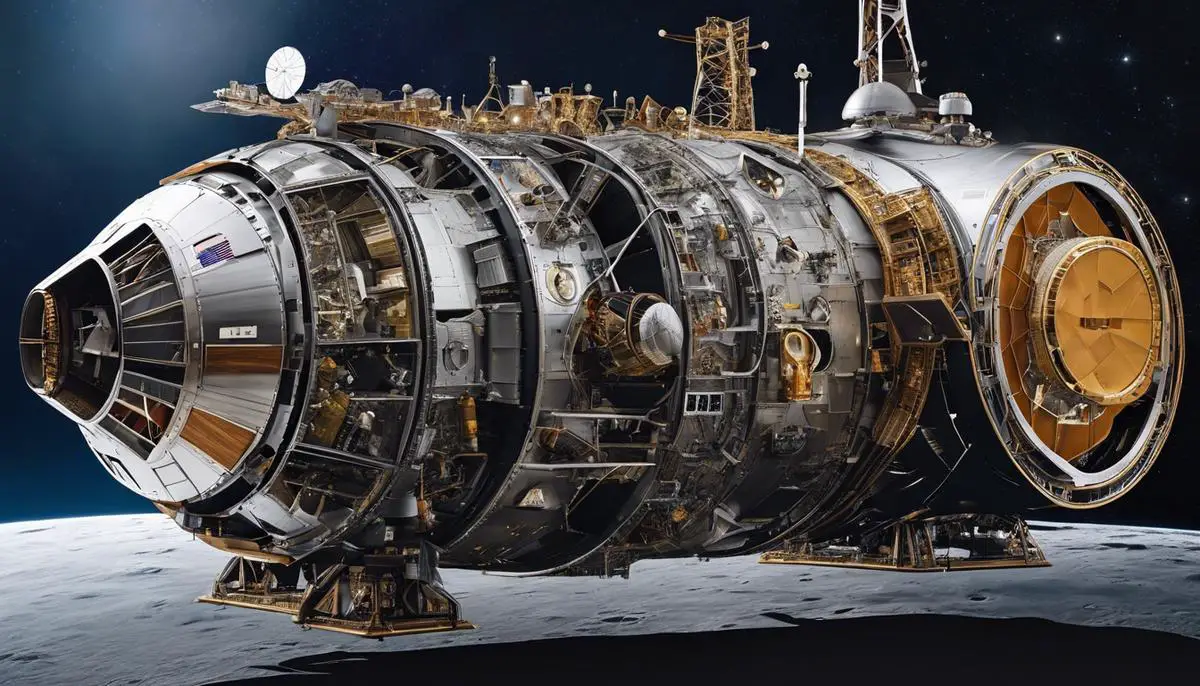Embarking on an unprecedented voyage through the cosmos, the Apollo 11 mission stands as a testament to human ingenuity and determination. At its heart lay the meticulously engineered Apollo spacecraft, a trio of interconnected modules designed to surmount the daunting challenges of lunar exploration. With an intricate melding of the Command Module (CM), the Service Module (SM), and the Lunar Module (LM), these technological marvels hailed a new era of space travel. The significance of their configuration went far beyond mere architecture; they were the physical embodiment of dreams and mathematically precise necessities. As we delve into the fabric of their creation, we unravel a saga of innovation that powered a celestial journey and revolutionized our understanding of what is achievable.
Contents
Design and Structure of the Apollo Spacecraft
Title: The Ingenious Engineering of the Apollo Spacecraft
The Apollo spacecraft, a crowning achievement of 20th-century engineering, was conceived and materialized through the collaborative endeavor of scientists, engineers, and technicians. Its historical mission, to land humans on the Moon and ensure their safe return to Earth, marked a pinnacle of human ingenuity and the culmination of an era of unprecedented investment in aerospace technology.
The fundamental design of the Apollo spacecraft can be divided into three distinct modules, each crafted to fulfill a crucial aspect of the mission: the Command Module (CM), the Service Module (SM), and the Lunar Module (LM). The CM, named such due to its role as the control center, housed the astronaut crew and the essential navigational and life-support systems. It was the only module designed to re-enter Earth’s atmosphere, safeguarding the astronauts within its ablative heat shield from the scorching temperatures of atmospheric re-entry.
Adjacent to the CM, the SM provided vital service functions, carrying the spacecraft’s main propulsion system and auxiliary consumables. The propulsion capabilities afforded by the SM were paramount during the Trans-Lunar Injection (TLI) — a critical maneuver which propelled the spacecraft from Earth’s orbit towards the Moon — and mid-course corrections. Upon the completion of its duties, it was jettisoned, its contributions to the mission complete.
Arguably the most specialized component, the LM was a marvel of innovative design, constructed for singular-purpose use on the lunar surface. The component itself was bifurcated into an ascent stage, which harbored the ascent engine and the cockpit for the astronauts when they left the Moon, and a descent stage, equipped with the lunar landing gear, descent engine, and a suite of scientific instruments fitted to collect lunar samples and conduct experiments. This separation catered to the conservation of mass, a tenet paramount to space travel.
Notably, the LM employed an ascent engine with hypergolic propellants, igniting upon contact, thus requiring no ignition system. This reliability was crucial for the astronauts’ liftoff from the Moon’s surface and their subsequent rendezvous with the CM in lunar orbit.
Environmental control within the spacecraft modules ensured the regulation of cabin pressure, temperature, and a breathable atmosphere, a feat achieved through meticulous recycling and management of water and oxygen. This crucial system allowed for life maintenance far outside the earthly realm, in the unforgiving vacuum of space.
To facilitate navigation, the spacecraft united the efforts of human calculus with nascent computer technology. The Apollo Guidance Computer (AGC), revolutionary for its time, was fundamental, assisting with real-time computational duties, including flight control and the execution of navigational operations, with astronauts and mission control maintaining oversight.
Finally, one must not overlook the Saturn V launch vehicle, which served as the vestibule to the cosmos for the Apollo spacecraft. Without such a powerful and meticulously engineered rocket, the journey from Earth could have never commenced. The three-stage rocket was the culmination of extensive research in propulsion technology, aerodynamics, and structural integrity.
The coordinated labor of these complex, interacting systems culminated in the historic Apollo missions. They represent a symphony of multidisciplinary expertise conceptualized and operated with a single, unifying objective: to push beyond the confines of our planet and set a precedent for human exploration.
It is this heritage of relentless human curiosity and technological advancement that continues to inspire and propel our cosmic endeavors today and into the future. The Apollo spacecraft was not merely a vessel; it was the crystallization of human aspiration, propelled skyward upon the pillars of science and engineering.
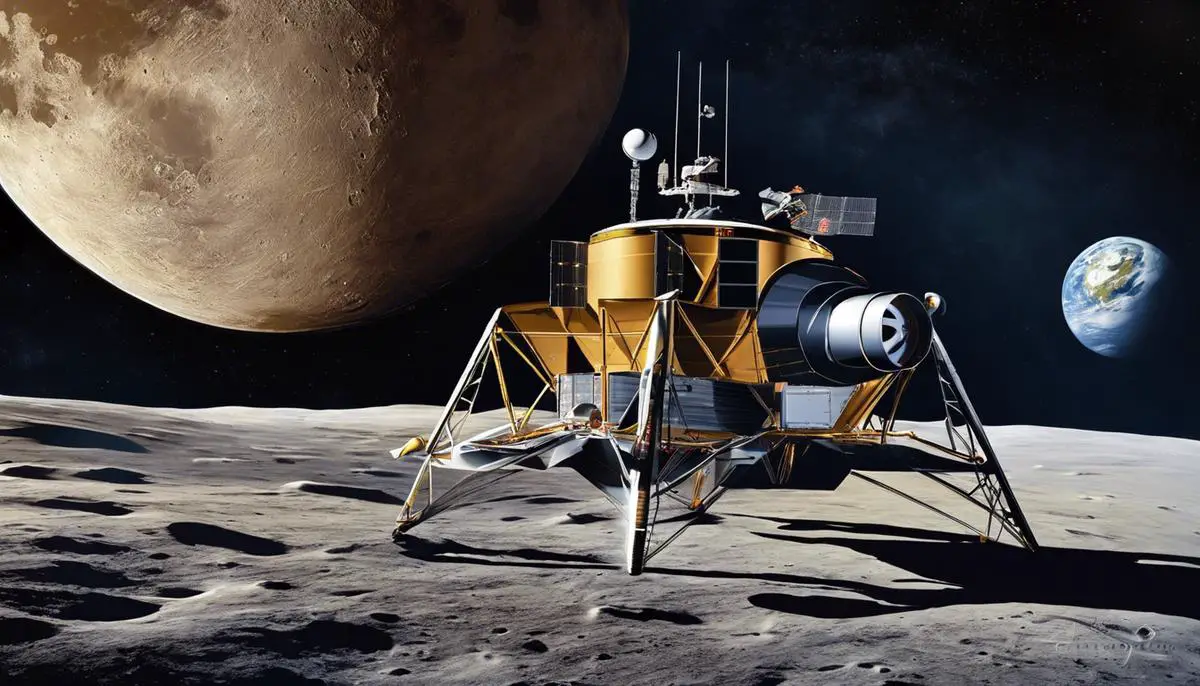
Title: The Precision Pathway to the Pale Lunar Realm: Navigational Systems of Apollo 11
Advances in astrodynamics and celestial navigation were the silent sentinels guiding the brave crew of Apollo 11 through the vast emptiness of space to their historic lunar rendezvous. Positioning a spacecraft accurately en route to the Moon requires an intricate ballet of high-precision instruments and pioneering computational techniques. This article elucidates the advanced navigational systems that shepherded Apollo 11 on its celestial journey, ensuring humanity’s first footprints on extraterrestrial soil.
Beyond the foundational work of the Apollo Guidance Computer, the success of the mission hinged upon the integration of several key navigational subsystems. The alignment optical telescope, colloquially known as the AOT, served as the astronauts’ celestial sextant. Through assiduous star sightings, the AOT allowed for regular recalibration of the spacecraft’s inertial measurement unit (IMU), mitigating inertial drift and providing an accurate frame of reference.
The inertial measurement unit, a state-of-the-art three-axis stabilized platform, played a critical role in spatial orientation. Embedded gyroscopes and accelerometers relayed data on the spacecraft’s attitude and acceleration to the AGC, equipping the on-board system with real-time spatial computations essential for trajectory corrections.
Radio-frequency communications also served as a pivotal navigational aid via the Unified S-Band (USB) system. This technology enabled both tracking and two-way communication between Mission Control and Apollo 11. Ground stations on Earth transmitted a signal to the spacecraft, which was then reflected back, delivering crucial data on range and velocity vectors through doppler effects. This technique known as “ranging,” when synthesized with the computational might of the AGC, helped refine mission trajectory with unerring precision.
Additionally, the transposition, docking, and extraction (TD&E) sequence cemented the prowess of Apollo’s navigational virtuosity. Following translunar injection, the Command and Service Module (CSM) separated from the Saturn IVB upper stage, performed a 180-degree roll, and then docked with the Lunar Module. Such a maneuver required meticulous alignment, further underscoring the monumental advance in spacecraft navigation and control.
The rendezvous radar, an instrumental piece of the lunar descent’s technology puzzle, tracked the relative motion between the LM and the CSM during the critical phase of lunar orbit rendezvous. This system afforded the astronauts with a real-time data stream, charting the course for a successful LM ascent from the lunar surface and reunion with the awaiting CSM for their homeward voyage.
The celestial mechanics governing lunar navigation were underpinned by the foundational work of the Massachusetts Institute of Technology’s Instrumentation Laboratory, now known as Draper Laboratory. The methodologies developed here translated into programming feats within the AGC – a historical juncture melding human intellect with computational ingenuity.
These systems, when woven together, formed a navigational web of unfathomable intricacy – each strand a testament to the triumph of human innovation. The expeditions to the Moon stand not solely as milestones in extraterrestrial travel but affirmations of the celestial navigational prowess cradled in the heart of the Apollo spacecraft. The silent diligence of these systems was vital to the defining Lunar Orbit Insertion and, ultimately, to ensuring that Apollo 11 etched its legacy upon the Moon’s desolate expanse.
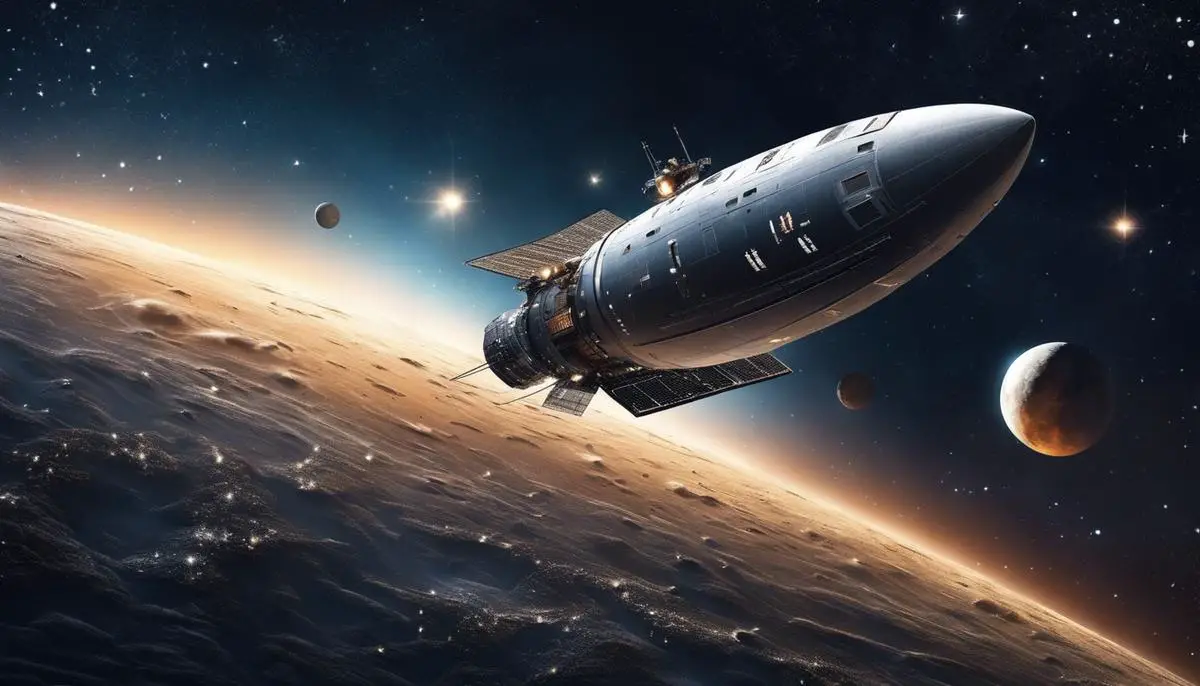
Propulsion and Power Systems of Apollo 11
The propulsion and power systems that facilitated the monumental success of Apollo 11 were feats of engineering that propelled humankind into a new era of exploration. Central to these systems were the engines that powered the Saturn V rocket, the Service Module (SM), and the Lunar Module (LM), along with the energy sources that sustained these engines and the spacecraft’s vital functions throughout the mission.
The Saturn V’s first stage was powered by five F-1 engines, which burned a refined form of kerosene (RP-1) with liquid oxygen (LOX) to produce a combined thrust of 7.6 million pounds-force, lifting the spacecraft beyond the Earth’s thick lower atmosphere. The second stage’s five J-2 engines transitioned to burn liquid hydrogen and LOX, these high-efficiency engines were key to reaching Earth’s orbit. The third stage, housing a single J-2 engine, provided the thrust necessary to propel the spacecraft from Earth orbit towards the Moon, a maneuver known as the Trans-Lunar Injection (TLI).
Upon reaching lunar orbit, the Service Module’s Service Propulsion System (SPS) took a center role. This singular engine, with the capability for multiple restarts, was pivotal for inserting and maintaining the spacecraft in lunar orbit, as well as for the crucial burn that initiated the return to Earth. With a deep throttle capability and reliability proven through rigorous testing, the SPS was a linchpin in the Apollo 11 mission’s success.
In parallel with propulsion, the power systems onboard Apollo 11 were masterpieces of energy management and supply. The Service Module was equipped with three fuel cells that generated electrical power by combining hydrogen and oxygen, with water as a by-product. This provided a reliable source of electricity for all Command and Service Module systems. The technology of the fuel cells represented a notable advancement, as they not only supplied power but also potable water for astronauts.
The Lunar Module’s Descent Propulsion System (DPS) and Ascent Propulsion System (APS) were both critical to the lunar landing and return. The DPS featured an engine designed for a powered descent onto the Moon’s surface, including variable throttle control which allowed for precise altitude and velocity adjustments. Also utilizing hypergolic propellants, which ignite upon contact, ensured the reliability of engine starts under the void of lunar conditions.
Apollo 11’s success hinged upon these meticulously engineered propulsion and power systems, demonstrating the apex of technological ingenuity of the time. Masterful integration of chemical, electrical, and mechanical systems underpinned humanity’s first steps onto extraterrestrial soil and functioned as a bedrock for the countless subsequent endeavors into the great cosmic beyond. Notably, the legacy of such systems continues to inform the design of contemporary spacecraft, ensuring that the epic journey of Apollo 11 will long resonate through the annals of space exploration history.
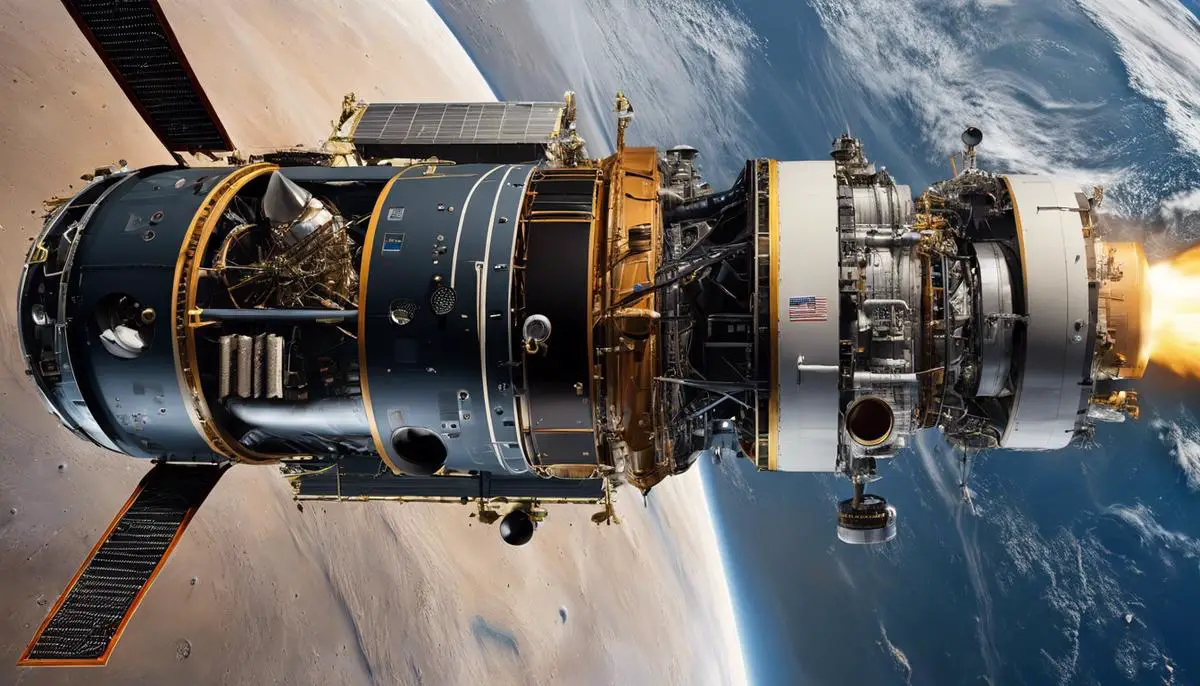
Life Support and Environmental Control
Fundamental to the success of Apollo 11 was the life support apparatus that sustained human life throughout the harrowing journey to the Moon and back. Vital subsistence became a reality through numerous interlinked systems within the spacecraft, ranging from oxygen supply to waste management.
A primary life support system (PLSS) was integrated within the spacesuits of astronauts Neil Armstrong and Buzz Aldrin during their historic lunar extravehicular activities. This portable unit contained oxygen for inhalation, a lithium hydroxide canister for carbon dioxide absorption, a cooling system to regulate suit temperature, and radio communication devices.
Within the confined quarters of the Command Module (CM) and the Lunar Module (LM), an environmental control system managed the dispensation of oxygen from high-pressure tanks, while expelling carbon dioxide through lithium hydroxide canisters—mirroring the PLSS functionality on a larger scale. Temperature control within these modules was achieved by a combination of passive thermal insulation and active thermal control systems, including electric heaters and evaporators, which maintained the environment within habitable bounds.
Water, a critical resource for astronaut survival, was a byproduct of the spacecraft’s fuel cells in the Service Module (SM). These fuel cells combined hydrogen and oxygen to generate electricity, simultaneously producing potable water which was stored in tanks for consumption by the crew during their mission.
For waste disposal, contingency measures allowed for the collection and storage of solid and liquid waste. Personal hygiene was maintained despite the spacecraft’s confined conditions using specially designed devices that facilitated the astronauts’ bodily functions while minimizing contamination of the onboard environment.
The overall environmental control and life support system for Apollo 11 was a marvel of engineering, designed to operate autonomously with the ability to address the unexpected. The reliability of this system was a testament to the foresight and scrupulousness of the engineers and scientists tasked with its design and execution—their contribution underpinning the very possibility of manned space exploration.
The support afforded by the Apollo 11 spacecraft in sustaining human life through rigorous environmental control, resource generation, and waste management systems was an unequivocal factor in the mission’s success. This achievement set a standard for all subsequent manned missions, serving as the foundation upon which the pursuit of space travel has been elevated to the complexities of modern missions, including those aimed at prolonged habitation in space.

Communication Systems and Mission Tracking
Communication and Tracking: The Neurological Nexus of Apollo 11’s Odyssey
Upon ensuring the satisfactory functionality of the Command Module (CM), Service Module (SM), and Lunar Module (LM), as well as the life support and navigation systems, the communication with Earth and the elaborate tracking mechanisms during the Apollo 11 mission merit attention. These systems were not merely supplementary; they were the linchpins of mission integrity, enabling a synergy between the astronauts and Mission Control that stretched across the vastness of cislunar space.
The Unified S-Band (USB) system served as the primary communication infrastructure, encapsulating telemetry, voice communication, and television signals in a seamless blend of modulated frequencies. This remarkable technology negated the cacophony of space, ensuring that the Apollo capsule’s whispers across the void were heard with crystalline clarity by ground stations of the Manned Space Flight Network (MSFN), sprinkled strategically across the globe.
The Disciplined Performance of Deep Space Network Antennae demanded precision engineering and foresight, encompassing stations in California, Spain, and Australia. Each station grasped the baton of transmission as Earth rotated, maintaining an unbroken auditory and data-exchanging lifeline to the spacecraft. High-gain and omnidirectional antennae on the CM alternated dependent on the module’s orientation, modulating receptions to wax and wane in the plight of ensuring robust connectivity.
Passive Thermal Control, or the ‘barbecue roll,’ conserved the spacecraft systems’ thermal equilibrium and further ameliorated communications as each antenna embraced a periodic vista of the celestial sphere and Earth.
Avid followers of the mission, and indeed the astronauts aboard, were introduced to a novel tracking and ranging system — the Spacecraft Lunar Module Adapter (SLA). Embedding transponders, this apparatus engaged in a delicate electronic ballet with the USB, marshaling the interlacing of navigational data with Earth-based MSFN stations, punctuating humanity’s tryst with the Moon, further rounded out by the doppler effect and the precision of radar reconnaissance.
Quantifiable Reflections: Ranging and Doppler Tracking composed the dual modalities of positional and velocity measurements. Ranging employed the phase comparison of a known signal against the received signal, permitting an accurate measure of distance. In contrast, the Doppler effect, born of the relative change in frequency of the signals due to the spacecraft’s motion, sufficed for velocity assessment.
The pivotal Computational Symphony of Ground-Based Assets cannot be overstated. The real-time computational juggernauts embedded within the confines of Mission Control — the IBM System/360 Model 75s, integrally operated with innovative software — parsed, processed, and projected the data streams into actionable insights, nurturing the space-bound crew.
Coupled with the celestial navigation prowess vested in the crew and the on-board Apollo Guidance Computer, this complex concatenation of information facilitated the critical course-correction burns and aligning definitions of midcourse navigation. This confluence of digital camaraderie not only foretold the Enhanced Public Understanding of Space Exploration, rendering transparent every heartbeat of the journey but irrefutably encapsulated the encapsulated the unfettered reliance on these methods.
Reflections upon the efficacy of communication and tracking during Apollo 11’s journey reveal a multifaceted and interdependent system of extraordinary complexity. This intricate network, which bound spacecraft to ground control with invisible, yet unyielding, threads, stands as a benchmark of engineering mastery. It punctuates humanity’s inquisitive leap into the cosmos, ensuring safety, success, and — with poignant resonance — our collective arrival on a celestial body beyond our Earthly cradle. The epoch-defining strides taken in this domain echo in the technological tapestries of contemporary space endeavors and will resonate onwards as our voyages stretch further into the cosmos.
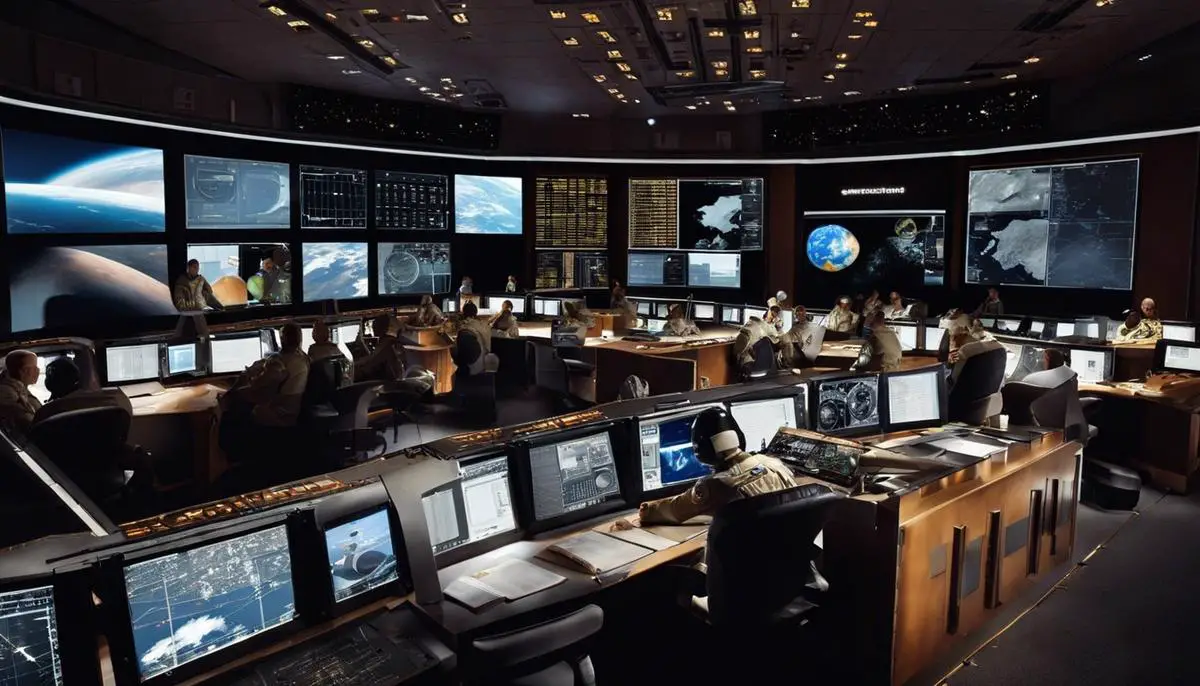
The voyage of Apollo 11 was an odyssey cast against the immense canvas of space, punctuated by the ingenuity encapsulated within its spacecraft. Our exploration into the vessel’s very sinews, from the thrumming propulsion systems to the life-sustaining environmental controls, paints a mosaic of human excellence. Stretching beyond mere technical achievement, the Apollo spacecraft emerged as a beacon of possibility. It carried with it the relentless spirit of adventure and the relentless pursuit of knowledge, marking an indelible chapter in the annals of human history. The mission’s ripples echo still, urging us to gaze skyward and venture into the cosmic ocean, well-equipped with the lessons of Apollo’s legacy.
